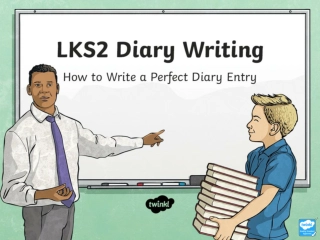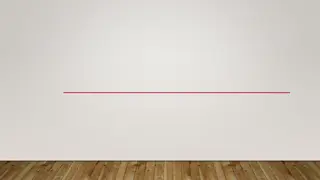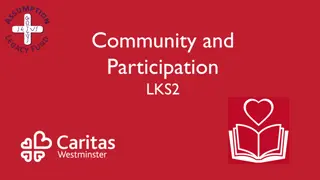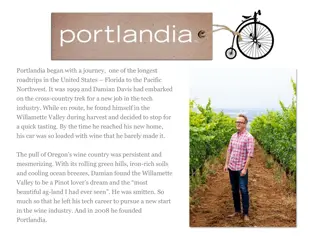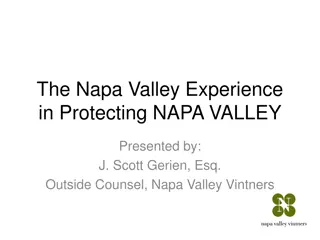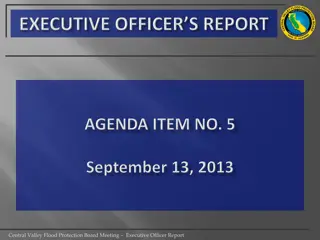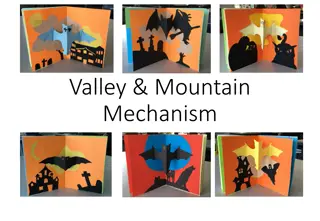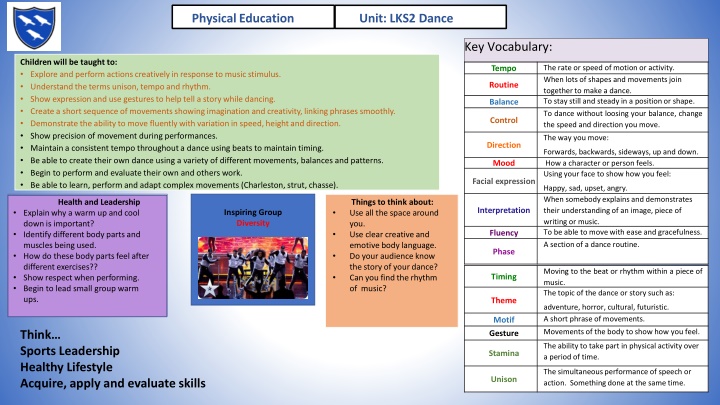
Dance and Gymnastics Key Vocabulary and Activities
Explore key vocabulary and activities for LKS2 Dance and Gymnastics units, including creative movements, expressions, speeds, and balances. Learn to perform sequences, use body language effectively, and understand the importance of warm-ups and cool-downs. Enhance physical skills, stamina, and leadership qualities in a fun and engaging way.
Download Presentation

Please find below an Image/Link to download the presentation.
The content on the website is provided AS IS for your information and personal use only. It may not be sold, licensed, or shared on other websites without obtaining consent from the author. If you encounter any issues during the download, it is possible that the publisher has removed the file from their server.
You are allowed to download the files provided on this website for personal or commercial use, subject to the condition that they are used lawfully. All files are the property of their respective owners.
The content on the website is provided AS IS for your information and personal use only. It may not be sold, licensed, or shared on other websites without obtaining consent from the author.
E N D
Presentation Transcript
Physical Education Unit: LKS2 Dance Key Vocabulary: Children will be taught to: Explore and perform actions creatively in response to music stimulus. Understand the terms unison, tempo and rhythm. Show expression and use gestures to help tell a story while dancing. Create a short sequence of movements showing imagination and creativity, linking phrases smoothly. Demonstrate the ability to move fluently with variation in speed, height and direction. Show precision of movement during performances. Maintain a consistent tempo throughout a dance using beats to maintain timing. Be able to create their own dance using a variety of different movements, balances and patterns. Begin to perform and evaluate their own and others work. Be able to learn, perform and adapt complex movements (Charleston, strut, chasse). The rate or speed of motion or activity. When lots of shapes and movements join together to make a dance. To stay still and steady in a position or shape. To dance without loosing your balance, change the speed and direction you move. Tempo Routine Balance Control The way you move: Direction Forwards, backwards, sideways, up and down. How a character or person feels. Using your face to show how you feel: Mood Facial expression Happy, sad, upset, angry. When somebody explains and demonstrates their understanding of an image, piece of writing or music. To be able to move with ease and gracefulness. A section of a dance routine. Health and Leadership Things to think about: Use all the space around you. Use clear creative and emotive body language. Do your audience know the story of your dance? Can you find the rhythm of music? Interpretation Explain why a warm up and cool down is important? Identify different body parts and muscles being used. How do these body parts feel after different exercises?? Show respect when performing. Begin to lead small group warm ups. Inspiring Group Diversity Fluency Phase Moving to the beat or rhythm within a piece of music. The topic of the dance or story such as: Timing Theme adventure, horror, cultural, futuristic. A short phrase of movements. Motif Gesture Movements of the body to show how you feel. Think Sports Leadership Healthy Lifestyle Acquire, apply and evaluate skills The ability to take part in physical activity over a period of time. Stamina The simultaneous performance of speech or action. Something done at the same time. Unison
Unit: LKS2 Gymnastics Physical Education Key Vocabulary: Sequence The order of movements within a routine. When lots of shapes and movements join together to make a dance. To stay still and steady in a position or shape. To dance without loosing your balance, change the speed and direction you move. Children will be taught to: Explore jumping techniques and link them with other gymnastic actions. Improve the ability to choose appropriate actions when creating a sequence of gymnastic movements to music. Be able to jump with a stable and safe landing in a variety of ways (pencil jump etc). Begin to develop different ways in travelling to help link movements (rolls, skipping etc). Identify and practice more complex shapes and balances such as pike, straddle and tuck. Begin to practise symmetrical and asymmetrical body shapes. Include counterparts and incorporate them into a sequence of movements. Perform a sequence using equipment. Perform and evaluate your own and others sequences. Routine Balance Control The way you move: Direction Forwards, backwards, sideways, up and down. Shapes created through the position of the body. The safe method performers have been taught to perform a skill such as a forward roll. How the performer decides to move within a routine on hands and feet. To be able to move with ease and gracefulness. A gymnastic skills such as a forward roll or balance. Body Shape Technique Health and Leadership Things to think about: Use all the space to perform. Use the safe teachnique you have been taught. Perform movements and balances with control. Are you linking your movements together smoothly? Travelling Explain why a warm up and cool down is important? Identify different body parts and muscles being used. How do these body parts feel after different exercises?? Show respect when performing. Begin to lead small group warm ups. Inspiring Athlete Max Whitlock Fluency Element When a balance is performed on a number of points of the body. Performing the same movements and physical actions at different time. Tensing muscles to create a stable shape. Making sure the environment around and techniques are performed properly. Point balances Canon Body tension Safety Think Sports Leadership Healthy Lifestyle Acquire, apply and evaluate skills Counter A balance where two performers take each others weight by pushing against each other. Balance A shape that has two completely identical sides that are around an axis. One half is not a mirror reflection of the other. Symmetrical Asymmetrical
Unit: LKS2 Athletics Physical Education Key Vocabulary: Children will be taught to: Run in different distances and at different speeds using good techniques. Apply throwing techniques to individual events such as howler, javelin, and discus. Show that they can use their legs as well as their arms when throwing. Learn and apply passing the baton techniques being able to do this at pace. Understand the rules required to complete the standing long jump. Show control and precision when performing different jumps. Select and maintain a running pace for different distances. Begin to discuss different techniques when running (striding, arm action and knee lift). Show a video of sprinting and marathon runners as an example of different techniques. Learn the pull technique for throwing developing on from Year 3 s learning. To keep steady on their feet while moving and performing skills. Changing the speed and direction you move and keeping balanced whilst doing it. The safe method performers have been taught to perform a skill such as javelin and standing long jump. To be able to move and perform skills with ease. Balance Control Technique Fluency Being able to make passes and tags making sure they get to the location the player is aiming for. The ability to perform physical activity for a sustained period of time. A short tube passed between runner in a relay. Accuracy Health and Leadership Inspiring Athlete Dina-Asher Smith Greg Rutherford Things to think about: Where should your hand and arm be ready for the baton handover? When jumping, are you in control with your landing? Use and practice correct throwing techniques. Why is pace important when running? Explain why a warm up and cool down is important? Identify different body parts and muscles being used. How do these body parts feel after different exercises?? Show respect when performing. Begin to lead small group warm ups. Stamina Baton A race where teams of runners pass a baton to each member of their team. Relay The speed at which someone moves. Pace/Speed Usually your top speed to run as fast as you can to get from A to B. Sprint Picking something up and giving it force to travel through the air and land in a different location. Think Sports Leadership Healthy Lifestyle Acquire, apply and evaluate skills Throw
Physical Education LKS2: OOA/Orienteering Key Vocabulary: This is the card carried by each team to identify what they find at each marker. Children will be taught to: Follow a map in a familiar context (school playground). Move from one point to another following a map. Use clues to help them follow a route on a map. Begin to show good communications skills when working with others. Be familiar with and understand key vocabulary: key, route, tactics etc. Follow a route on a map safely. Apply direction when navigating a map (left, right, forward, backwards). Follow a map in a more familiar demanding context. Move from one location to another using a map. Follow a route accurately, safely and within a time limit. Begin to apply tactics to plan the best way to navigate a map within a certain time. Control Card The stations scattered throughout a course that each team should visit. Control marker This is setting the map so it is held the right way round. You can find your location on the map using features. The ability to perform physical activity for a sustained period of time. Orientating the map. Stamina Using the markers and grids on the map to identify locations of control markers. Grid reference/ Coordinates Communicating and working with others to establish a goal. Teamwork A set of symbols that marks human and physical features on a map. Health and Leadership Key Things to think about: Explain why a warm up and cool down is important? Do we just use our physical skills in this activity? How does OOA keep us healthy? Show respect when performing. How can you demonstrate leadership qualities? Is your map orientated correctly? Make sure that your instructions are clear and precise. What leadership qualities can you apply when orienteering? How will you decide what route you will follow or which clue you will answer first? The direction they aim to go in order the visit each control marker. Route The plan and approach taken to try to win the competition. Tactics Plan or direct something/someone through a course or route using a map. Navigate Think Sports Leadership Healthy Lifestyle Acquire, apply and evaluate skills
Physical Education Unit: LKS2 Invasion Games Key Vocabulary: * Please see the inspiring athletes attached with sport specific knowledge organisers. Balance To stay still and steady in a position orshape. Children will be taught to: Apply tactics to a variety of different invasion games and the terms attack and defence. Apply hand-eye coordination into game situations. Continue to apply Agility, Balance and Coordination but advancing this into a competitive situation. Be able to work as a team (showing motivation, sportsmanship). Apply teamwork when attacking and defending in games. Understand rules of different games and begin to understand the positions in relevant sports. Choose suitable tactics to defend, attack, pass and receive the ball when playing a game. Be able to evaluate their own and peers performances, identifying how to improve using good communication skills. Begin to understand the concept of space in invasion games and the importance of creating it. To perform movements and skillswithout loosing your balance, change the speedand direction youmove. Movement made towards theoppositions goal within a game to scorepoints. Movements made to protect thehome teams goal, preventing the oppositionfrom scoring. To pass the ball to a team mate using one bounce. When dribbling be able to move in a sideto sidemotion. The ability to move two or more body parts under control, smoothly and efficiently. Control Attack Defend Bounce Pass Weave Coordination Health and Leadership Ambition & Aspiration There is more to sport than just playing: - Physio - Coach - Manager - Referee - Nutritionist - Analyst Things to think about: Passing to your team mates accurately using the techniques taught. How can you involve yourself in games? Why is it important to evaluate our performances? Does teamwork really make a difference? Explain the importance of a warm up and begin to lead in small groups? Explore the muscles and body parts being used, how do they feel in different situation? What can we do to keep fit? Show respect when performing. How can you demonstrate leadership qualities? The ability to change the direction of the body in an efficient and effective manner. Agility When a player stands to close and prevents the opposition from passing and shooting. Obstruction When the ball is passed to a player. They are able to catch, trap or control it. Receive Planning something to achieve a goal Tactic Think Sports Leadership Healthy Lifestyle Acquire, apply and evaluate skills Being able to make a pass directly to another team mate. Accuracy
Unit: LKS2 Striking & Fielding Physical Education * Please see the inspiring athletes attached with sport specific knowledge organisers. Key Vocabulary: An object throw from the shouldand then forced forward. This throw isgreat for longerdistances. Using an object to throw over ashort distance accurately. It involves the transference of weight forwards as the straight-t throwing arm swings through from the back to the front to release the object at hipheight. A person who is on the team which are bowling. Their job is to catch the ball and return it to the bowler quickly. Hitting a ball or object into anopen space in the playingarea. When the ball is passed to a player. Theyare able to stop, catch or trap it and move on withit. Children will be taught to: Begin to apply simple tactics and skills to small sided games. Identify and follow rules in a variety of games. Continue to develop the basic throwing techniques (underarm, overarm, bounce and chest). Throw and hit a ball in different ways (high, low, fast, slow). Move and follow their passes in order to create space, ensuring accuracy and control is still evident. Understand the importance of both striking and fielding. Apply agility, coordination and balance when fielding. Know when to use the correct throwing technique (distance and overarm). Continue to practise striking techniques. Develop receiving skills using the long leg barrier. Overarmthrow Underarmthrow Fielder Strike Health and Leadership Receive Ambition & Aspiration There is more to sport than just playing: - Physio - Coach - Manager - Referee - Nutritionist - Analyst Things to think about: Are you applying the techniques that you have been taught? What is more important striking or fielding? When you are throwing is it accurate and controlled? When would you not use a bounce pass? Explain the importance of a warm up and begin to lead in small groups? Explore the muscles and body parts being used, how do they feel in different situation? What can we do to keep fit? Show respect when performing. How can you demonstrate leadership qualities? Being able to make passes and shotsmaking sure they get to the location the playeris aimingfor. Accuracy Sending the ball to another member ofyour team. To perform movements and skills without loosing your balance, change the speed and direction you move. Passing Control Think Sports Leadership Healthy Lifestyle Acquire, apply and evaluate skills The person who bowls the ball. Bowler The safe method performers have been taught to perform a skill such as serving and forehand. Technique
Unit: Swimming Physical Education Key Vocabulary: Children learn how to swim and be taught how to stay safe in and around water. Swim with your chest facing down and push your arms ahead under the water and then pull yourself forwards while doing the frog kick. A swimming stroke; arms are moved alternately overhead accompanied by a flutter kick. Arms rotating backwards instead of forwards and feet kicking. Useful when learning to swim, for floating, for rescue reaching, in various forms of water play, and for aquatic exercise. In this style you swim face-down and circle your arms forwards through the air and backwards through the water while doing the flutter kick. Rotate both arms forward just above the water and then use them to pull your body through the water while lifting your chest and head into the air. At the same time you propel your body forward with a rhythmic leg movement called the dolphin kick. Water Safety Children will be taught to: Perform safe self-rescue in different water based situations Swim competently, confidently and proficiently over a distance of at least 25 metres Use a range of strokes effectively, for example, front crawl, backstroke and breaststroke Breaststroke Front Crawl Backstroke Safety Remove all jewelry including earrings. Long hair must be tied back. Wear suitable footwear. Wear goggle if it is needed. Use correct techniques. Inspiring Athlete Ellie Simmonds Things to think about: Arm technique Leg technique. Using correct breathing techniques. Are we ensuring that we are swimming safely? Noodle Inspiring Athlete Dina-Asher Smith Freestyle Health and Leadership Are we using different body parts than if we were doing a sport on land? Is our breathing technique just important in the pool? Showing respect to one another. Motivating and encouraging our peers. Butterfly Think Sports Leadership Healthy Lifestyle Acquire, apply and evaluate skills * Remember to keep a log of those children taking part in swimming lessons and the distances they can swim.

